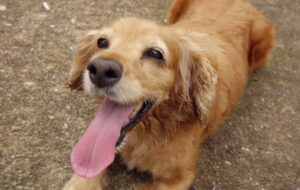Panting in dogs is normal behavior. But for some, heavy panting can be a sign of heart failure, heat stroke, pain, or illness. Can you spot what’s normal and what’s not?
This article explains what vets wish you knew about excessive panting in dogs, so you can take action when needed.
What’s Normal and What’s Not
An active Labrador plays ball on a hot day. They pant to cool off. This is normal. But what if the same Labrador was at home, resting, and they were panting heavily? Is this normal?
The first thing vets want you to recognize is what’s normal for your dog and what’s not.
Resting Respiratory Rate
A good starting point is to know your dog’s normal resting respiratory rate. This is simply the number of breaths taken each minute when the dog is asleep.
To work this out, wait until the dog is asleep. Without touching them, watch the movement of their chest wall. One breath uses two movements (the rise of the chest as the dog breaths in, then the fall of the chest as they breathe out.)
- A normal resting respiratory rate is 10 – 35 breaths per minute
Spotting a Change
For a flat-faced pug panting even on a cool day is normal. By recognizing your dog’s ‘normal’ you can spot telltale changes early.
A PetPace collar is great for this. Amongst other parameters, it records the pet’s breathing rate in an easy-to-read chart. Also, when that pattern changes unexpectedly, the collar sends an alert to your smartphone.
Excessive panting in dogs can be a vital clue that the dog has a problem. This is especially important for:
- Flat-faced breeds such as Boxers, Boston Terriers, Pugs, and Bulldogs
- Pregnant dogs
- Those with health problems such as heart failure or lung diseases such as bronchitis or asthma.
Know your dog. Only when you know what’s normal can you quickly spot when something isn’t right.
Causes of Heavy Panting in Dogs
To understand how significant excessive panting in dogs can be let’s look at the causes of panting, some more serious than others.
- Cooling off: Dogs can’t sweat and panting is their main way to lose heat
- Excitement: excited or nervous dogs may pant as well
- Pain: From toothache to arthritis, discomfort causes panting.
- Nausea: Whether due to garbage gut or pancreatitis, panting in dogs can be a sign of nausea
- Respiratory difficulties, such as:
- Bronchitis
- Chest infection
- Laryngeal paralysis
- Lung tumor
- Lungworm
- Fluid on lungs (due to heart failure)
- Heart disease
- Cushing disease – a hormonal disease, also involving excessive drinking
- Certain medications such as steroids
- Eclampsia in a nursing dog
Spotting Problems: Questions to Ask Yourself
Should you contact the vet? If you are worried, always call the vet. But if you aren’t certain what to do, ask yourself these questions.
Does my dog breathe heavily at rest?
Count the dog’s resting respiratory rate or use the PetPace graphic. The latter monitors the dog 24/7 so patterns are easy to spot.
If the dog is breathing heavily, especially if they have a known health problem, then contact the vet. It might be the dog’s medication needs a dose change.
Is heavy panting normal for my dog?
Each dog is an individual and may pant when hot, excited, or after heavy exercise. However, if they continue to pant heavily long after their walk, this may be significant. Vets want you to be alert for changes from the norm.
Is heavy panting a sign my dog is distressed?
Certain breeds (those flat-faced fur friends) pant most of the time. This makes it even more crucial to spot when they’re distressed. This may require you to recognize that their body temperature is rising or heart racing (e.g. as a precursor to heat stroke).
A PetPace collar gathers all this data (respiratory rate, heart rate, body temperature, and activity levels) and sends alerts when abnormal values are detected.
Does the breathing sound abnormal?
As well as heavy panting in dogs, be mindful of HOW they are breathing. Look for the following:
- Honking noise: A sign of laryngeal paralysis
- Wheeziness: Possible asthma
- Harsh breathing and/or coughing: Bronchitis, pneumonia, Heart disease, lung tumor, heartworm, or lungworm
Has Anything else changed?
Other clues that heavy panting indicates a problem includes changes such as:
- Lack of energy
- Poor appetite
- Lameness
- Raised temperature
- Stomach upsets
- Excessive thirst and urination
When to See a Vet
Unusual heavy panting in dogs should be taken note of. It’s also important to recognize changes from the norm, including activity levels or body temperature.
A PetPace collar monitors your dog’s vital signs so that you don’t have to. This allows you to relax safe in the knowledge that if something changes, PetPace will alert you This helps catch problems early, but could also avoid unnecessary vet trips. But as always, listen to your gut instinct. If you’re worried, call the vet for advice.

